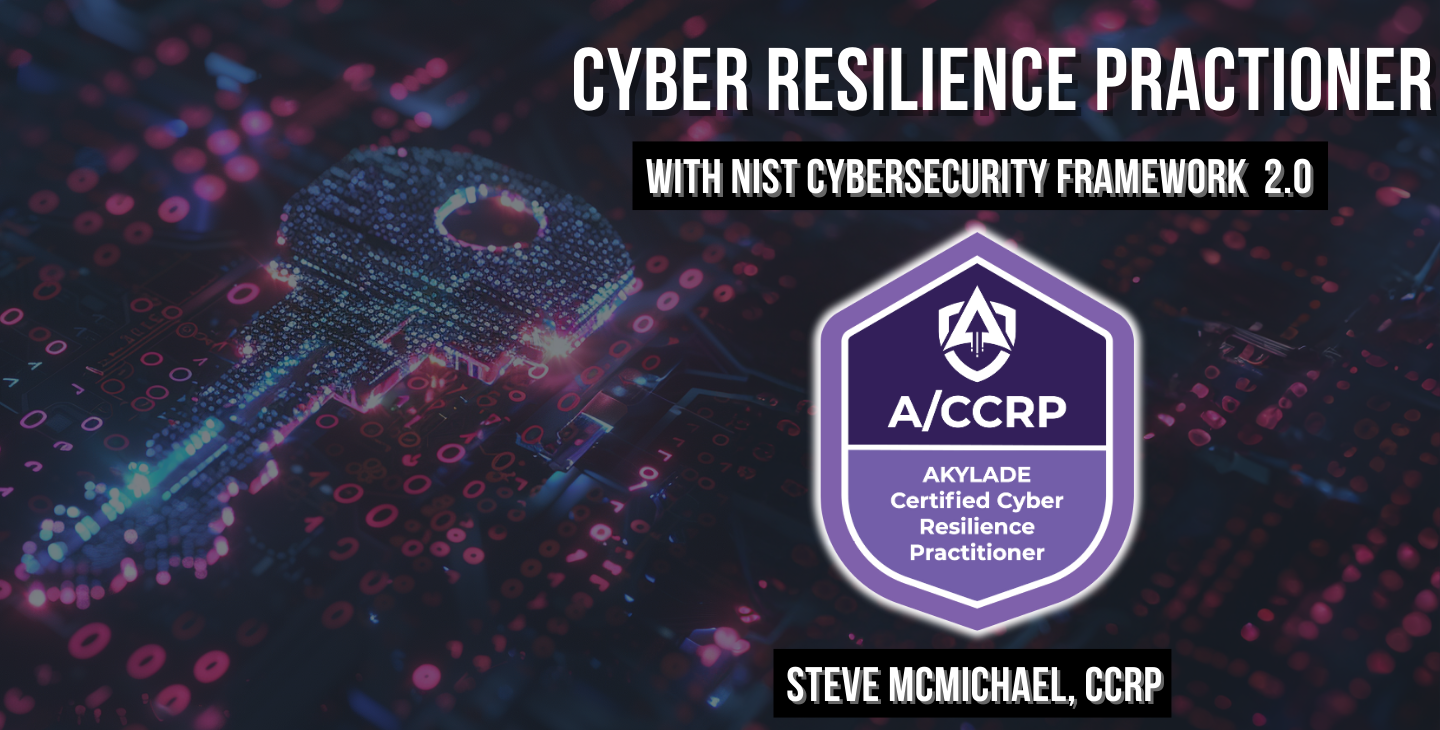- CPA to Cybersecurity
- Posts
- How to Become an AKYLADE Certified Cyber Resilience Practitioner (A/CCRP)
How to Become an AKYLADE Certified Cyber Resilience Practitioner (A/CCRP)
Course Just Launched in Simply Cyber Academy!
Are you ready to lead the team or be an independent consultant? Stand on the foundation of what you learned in AKYLADE Certified Cyber Resilience Fundamentals (A/CCRF), to master the NIST Cybersecurity Framework (CSF) and elevate your career.
What is the A/CCRP certification?
Cyber resilience is quickly becoming one of the most important concepts in the world of cybersecurity. It's not just about preventing attacks, but about being able to withstand and recover from them.
The A/CCRP is an intermediate step in the GRC Certification Roadmap. It takes us beyond what organizations need to do become cyber resilient, as defined by NIST in the Cybersecurity Framework, with a process for how to do it. AKYLADE calls this process making a Cyber Risk Management Action Plan, or CR-MAP. CR-MAP is a field tested, step-by-step framework for assessing and managing cyber risks in any organization.
The A/CCRP certification demonstrates the holder's practical knowledge of the NIST Cybersecurity Framework (CSF) version 2.0, and their ability to apply a CR-MAP process to plan, influence, manage, and optimize cybersecurity resilience in organizations. It focuses on real-world scenarios and problem-solving skills required for internal and external cybersecurity consultants.
How is the A/CCRP different from the AKYLADE Certified Cyber Resilience Fundamentals (A/CCRF)?
The A/CCRF focuses on foundational knowledge of the NIST CSF, using mostly definitional and multiple-choice questions. The A/CCRP builds on this foundation and tests practical application through case study-based scenarios, evaluating the candidate's ability to analyze situations and make strategic decisions related to cybersecurity risk management.
What are the key skills tested in the A/CCRP exam?
The ACCRP exam assesses your ability to:
Coordinate with management to gain buy-in for cybersecurity initiatives.
Establish risk profiles for organizations.
Discover and prioritize top cybersecurity risks.
Develop and tailor a cyber risk management strategy.
Create and implement a Cyber Risk Management Action Plan (CRMAP).
Maintain and update the organization's cybersecurity risk posture.
There’s more information on the course page in the Simply Cyber Academy:
How is AKYLADE different from other cybersecurity certification providers?
AKYLADE distinguishes itself by:
Focusing on practical skills and real-world application.
Developing certifications in collaboration with hiring managers, addressing market gaps and ensuring relevance.
Offering deep dives into specific cybersecurity areas hiring managers consider gaps, like the NIST CSF and risk management.
Emphasizing practical application of the NIST Cybersecurity Framework (CSF) in real-world scenarios. It goes beyond theoretical knowledge, testing the ability to analyze situations and make strategic decisions.
Rigorous certification process, for accreditation: A/CCRP utilizes industry-standard practices for certification development, including job task analysis, independent question writing, and beta testing.
Making certifications accessible and affordable.
What can A/CCRP actually do for your career?
This cert can work well in a 70-20-10 experiences-relationships-education Career Development Plan. It shows employers that you're serious about cyber resilience and have the skills to back it up.
But it's not just about getting your foot in the door. The A/CCRP can also help you advance into leadership roles. As more companies wake up to the importance of cyber resilience, they're looking for people who can not only handle the technical side, but also communicate effectively and think strategically. I really like in this course the emphasis on enabling competencies and developing your business acumen.
Let's make this real with an example. Say you're a cybersecurity consultant hired by a medical device company. They're worried about supply chain attacks and device safety. Using the CR-MAP, you'd start by assessing their biggest risks. That means analyzing network diagrams and interviewing staff about security practices.
Based on what you find, you identify top 5 cyber risks and create a comprehensive plan for reasonable, repeatable cybersecurity practices. This could include technical solutions like firewalls and encryption, but also things like employee training and incident response procedures. You're looking at the big picture.
Then you guide them through implementing the plan, keeping an eye on progress and making adjustments as needed. You're like a coach, helping them build their cyber resilience muscles.
And that's really what the A/CCRP is all about - giving you the skills and framework to be that coach, that expert who can help any organization navigate the complex world of cyber resilience.
Bottom-Line
As you think about your own career journey, consider how the A/CCRP might fit in. How could a deep understanding of cyber resilience help you achieve your goals? How could you use the CR-MAP framework to make your organization, and our shared digital world, a little bit safer?
These are the kinds of questions the A/CCRP challenges us to ask. Because in the end, cyber resilience isn't just a technical challenge - it's a human one. It's about all of us working together to create a more secure, more resilient future.
